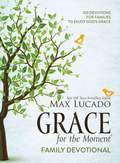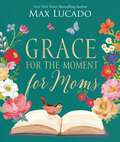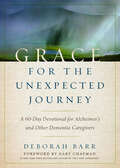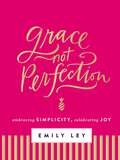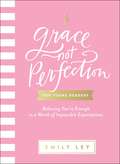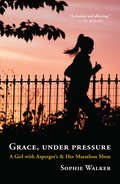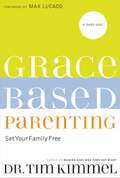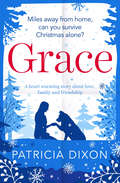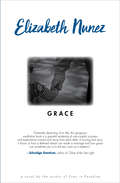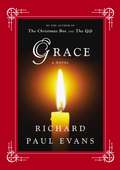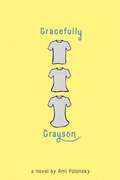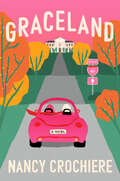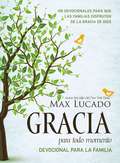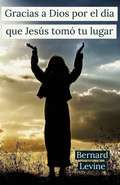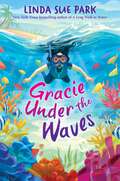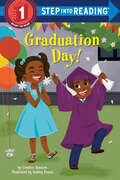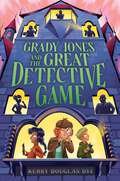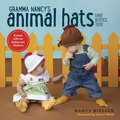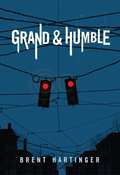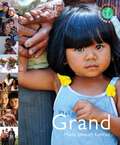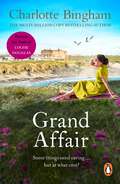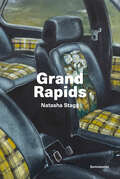- Table View
- List View
Grace for the Moment Family Devotional, Ebook: 100 Devotions for Families to Enjoy God’s Grace (A 100-Day Devotional)
by Max LucadoGrace for the Moment by New York Times bestselling author Max Lucado has inspired millions. Families can share the help and hope of God in everyday moments with their children by reading the family devotional edition. With 100 days of devotionals, this family-friendly edition includes a daily devotional for adults and a separate kid-friendly devotional that touches on the same topic. Grace for the Moment Family Devotional is a great resource for:families growing their faithparents hoping to jump-start a new habit of prayer with their childrenteaching children how to embrace a grateful heart and find inspiration on a daily basis Each daily devotional includes:a devotional for adults (on the left page)a Scripture for parents and children to read togethera devotional for kids (on the right page)a &“Growing in Grace&” activity and discussion question Grace for the Moment Family Devotional is a great gift for birthdays, adoption celebrations, baby showers, baptisms, and Christmas. This 100-day devotional will help your family enjoy quality time together by incorporating rich faith discussions, so that you can grow in Christ across the generations.
Grace for the Moment for Moms: Inspirational Thoughts of Encouragement and Appreciation for Moms (A 50-Day Devotional)
by Max LucadoDiscover the encouragement moms need to get through the bad days, the good days, and the everyday moments.You're the best, Mom. Mothers, for so many, are a welcoming hug, a helping hand, a comforting ear, a wise source of guidance. They do so much for so many, and in the devotional Grace for the Moment for Moms, bestselling author, husband, father, and grandfather Max Lucado offers moms comfort, encouragement, and some much-needed moments of grace and appreciation.You'll find Scripture-based devotions that:Encourage moms in their faith and help them embrace the hope of the LordRemind moms of God's grace over their lives and the lives of their children and grandchildrenInspirational insight on how to choose love, joy, peace, patience, kindness, and faithfulness in very real situations This compilation of 50 beautiful devotions from Max's bestselling brand also includes:A prayer for moms by MaxLovely design and illustrationsInspirational messages that remind moms how loved and appreciated they areWritten-out Bible verses to encourage and uplift mothers Whether a gift for your own mom or for a mom who means so much to you, this book is ideal for Mother's Day, birthdays, Valentine's Day, and more and will be a cherished favorite for years to come.Tell your mom thank you, I love you, and more with Grace for the Moment for Moms.
Grace for the Unexpected Journey: A 60-Day Devotional for Alzheimer's and Other Dementia Caregivers
by Deborah BarrFor the weary dementia or Alzheimer's caregiverIf you are a caregiver to someone with Alzheimer&’s or another type of dementia, you carry a heavy load. On top of having to watch someone you love suffer, you are probably losing sleep, growing frustrated, and struggling with loneliness or even depression. With little to no help and no time for a break, this unrelenting stress is hard to carry. Whether that&’s you or someone you know, the caregiver needs care, too. Grace for the Unexpected Journey: A 60-Day Devotional for Alzheimer&’s and Other Dementia Caregivers provides that support. Each daily devotion: Is short, ideal for demanding schedulesReflects on a relevant Scripture passageFeatures a relatable caregiving storyOffers a key Scripture for meditationDebbie Barr is a speaker, health educator, and the author of multiple books, including Keeping Love Alive As Memory Fades (coauthored with New York Times bestselling author Gary Chapman). As a health educator with a deep concern and compassion for dementia caregivers, she saw their need for faith-based encouragement. With compassion and understanding she uses Scriptures to address their practical hardships and spiritual concerns.When the struggles seem insurmountable, this devotional offers strength. When stress floods in, it points to peace. And when darkness falls, it illuminates hope. Caregivers walk a long, difficult road. This devotional gives grace for their journey.
Grace for the Unexpected Journey: A 60-Day Devotional for Alzheimer's and Other Dementia Caregivers
by Deborah BarrFor the weary dementia or Alzheimer's caregiverIf you are a caregiver to someone with Alzheimer&’s or another type of dementia, you carry a heavy load. On top of having to watch someone you love suffer, you are probably losing sleep, growing frustrated, and struggling with loneliness or even depression. With little to no help and no time for a break, this unrelenting stress is hard to carry. Whether that&’s you or someone you know, the caregiver needs care, too. Grace for the Unexpected Journey: A 60-Day Devotional for Alzheimer&’s and Other Dementia Caregivers provides that support. Each daily devotion: Is short, ideal for demanding schedulesReflects on a relevant Scripture passageFeatures a relatable caregiving storyOffers a key Scripture for meditationDebbie Barr is a speaker, health educator, and the author of multiple books, including Keeping Love Alive As Memory Fades (coauthored with New York Times bestselling author Gary Chapman). As a health educator with a deep concern and compassion for dementia caregivers, she saw their need for faith-based encouragement. With compassion and understanding she uses Scriptures to address their practical hardships and spiritual concerns.When the struggles seem insurmountable, this devotional offers strength. When stress floods in, it points to peace. And when darkness falls, it illuminates hope. Caregivers walk a long, difficult road. This devotional gives grace for their journey.
Grace, Fallen from (Wesleyan Poetry Series)
by Marianne BoruchIn her wry and riveting new collection, Marianne Boruch discovers things often taken for granted and holds them up to deceptively casual light, questioning them both mercilessly and mercifully. Employing a masterly range of tone and form, Boruch makes a sometimes strange but always revealing investigation of world and self, history and memory, resistance and release. Here a woman levitates behind a door as her daughter badly bangs out Mozart. Here God is caught before the moment of creation, before knowledge, before "the invention/ of the question too, the way all/ at heart are rhetorical, each leaf/ suddenly wedded to its shade." It's here raucous boys on their bikes are told—through telepathy—don't go to this war. Here, that a Dutch still life is returned to the small chaos of its making. And Eve, in "stained fascination," stares down the snake of the lost garden. The lyric impulse in these deeply interior poems stops time, even as the world, indifferent to its mystery, keeps happening.Praise for Marianne Boruch:"Her poems are complex rather than simple rooms … they bring the world's strangeness, and their own, home to whatever reader is open to old mysteries, both in dreams and in the waking life they illuminate."—Philip Booth, The Georgia Review"Marianne Boruch's (work) has the wonderful, commanding power of true attention: She sees and considers with intensity. Her poems often give fresh examples of how rare and thrilling it can be to notice."—Robert Pinsky, Book World, The Washington Post"Every detail of image and syntax shines with multiplicity."—Donald Revell, The Ohio Review
Grace, Not Perfection (with Bonus Content): Embracing Simplicity, Celebrating Joy (Tools and Strategies to Help You Simplify Your Space, Your Time, and Your Mind So You Can Slow Down and Enjoy Life)
by Emily LeyThis eBook includes the full text of the book plus an exclusive Overcoming Overwhelm ebook not found in the hardcover!Enjoy life more and focus on what matters most when you learn these easy ways to simplify your space, your time, and your mind.Are you ready for a new way of seeing your time? Have you been told you can have it all, only to end up exhausted and occasionally out of sorts with the people you love? Hold yourself and those you love to a more life-giving standard in Grace, Not Perfection, and allow that grace to seep into your days, your family, and your heart.As a busy wife, mother, and entrepreneur, Emily Ley came to a point when she suddenly realized she couldn't do it all. She needed to simplify her life, organize her days, and prioritize her priorities. She decided to hold herself to a standard of grace rather than perfection. This mantra led to the creation of her bestselling Simplified® planner. By embracing grace, not perfection, you will discover how to:Simplify your life by simplifying three major areas: your space, your time, and your mindCreate effective to-do lists and get through them one step at a timeCenter your day around an intentionally slower rhythm of life with various strategies Grace, Not Perfection is for busy moms or any woman who is looking to have more time for the things they value most in life. It is the ideal gift for Mother's Day, National Best Friend Day, birthdays, and holidays, or any special occasion.Designed with Emily Ley's signature aesthetic and gorgeous photography, Grace, Not Perfection gives you tangible ways to simplify your life, so you have more space to what matters most.
Grace, Not Perfection for Young Readers: Believing You're Enough in a World of Impossible Expectations
by Emily LeyAs she grows up in a generation that is busier and more distracted than ever, your tween girl will love the fun vibe and practical ideas in Grace, Not Perfection for Young Readers by bestselling author, creator of the Simplified Planner, and organizational expert Emily Ley.Today's fast-paced, technology-driven society affects all ages, but it's taking its biggest toll on our kids. Does your middle grader feel compelled to participate in a ton of activities, be an excellent student, take a perfect photo for every occasion, and be friends with as many people as possible--only to end up exhausted and anxious? Help her adopt a new, life-giving perspective in Grace, Not Perfection for Young Readers.With a colorful interior, plenty of photos, and actionable tips and lists, this young readers' edition of Emily Ley's popular book reminds you and your daughter that God offers abundant grace every day. Emily's ideas include how to . . .Create significant moments rather than orchestrating a picture-perfect life.Pare down activities to what matters most--without FOMO.Simplify life by simplifying three major areas: your space, your time, and your mind.Create effective to-do lists and get through them one step at a time.Perfect for back-to-school, Christmas, birthdays, and coming-of-age celebrations, Grace, Not Perfection for Young Readers is completely reimagined for a younger audience but still includes Emily's signature aesthetic and message. It's a great book to enjoy with your daughter as you find your own new freedom in the adult edition.Timely and engaging, Grace, Not Perfection for Young Readers helps tween girls embrace the most important elements of life, trim off the superficial and superfluous, let go of unrealistic standards, and journey toward adulthood with the right outlook and tools to have a simpler, grace-filled, and happy life.
Grace, Under Pressure
by Sophie WalkerWhen Sophie Walker's daughter Grace was diagnosed with Asperger Syndrome, her world unravelled. Her high-powered job was in disarray, she couldn't sleep, often woke in tears and felt hopeless and useless in her role as a mother. One day she realized she hadn't done any exercise for months, and had been neglecting her physical health as well as her mental wellbeing. Previously a keen runner, she set herself the challenge of running the London Marathon to raise awareness of Asperger Syndrome and make herself physically strong enough to care for her demanding daughter. Invigorated by the physical challenge she had set herself, Sophie began a blog - 'Grace Under Pressure' - writing about both day-to-day life bringing up Grace alongside training for the marathon. The combination caught the imagination of readers and the blog took off, garnering praise from a wide range of sources. Now transformed into a book, GRACE UNDER PRESSURE is a moving story that charts the highs and lows of raising a child with Asperger Syndrome and the physical challenge of training for a long-distance running event.
Grace-Based Parenting: Set Your Family Free (Grace Based Parenting Video Ser.)
by Tim KimmelParents in our post-modern world tend to be committed to but anxious about their child-rearing responsibilities. They've tried the countless parenting books on the market, but many of these are strident, fear-based books that loving parents instinctively reject, while still searching for direction.Now Dr. Tim Kimmel, founder of Family Matters ministries, offers a refreshing new look at parenting. Rejecting rigid rules and checklists that don't work, Dr. Kimmel recommends a parenting style that mirrors God's love, reflects His forgiveness, and displaces fear as a motivator for behavior. As we embrace the grace God offers, we begin to give it-creating a solid foundation for growingmorally strong and spiritually motivated children.Releasing in an affordable trade paper edition, this revolutionary bookpresents a whole new way to nurture a healthy family.
Grace: A Heartwarming Story about Love, Family and Friendship (The Destiny Series #4)
by Patricia DixonMiles away from home, can you survive Christmas alone? Singleton Grace loves Christmas and having all of her family with her on the day. But this year things will be different. One by one, each of her three children announce they have other plans for the holidays. After deciding it&’s time for a change, Grace books a cottage in the French countryside for Christmas. Max is also struggling with change after coming to terms with the end of his marriage. Making a spur of the moment decision, he heads to the Loire where he hopes to escape the festivities. In the meantime, Grace&’s children embark on their own Yuletide journeys. But when their plans begin to fall apart, they are all left wishing they were at home with their mum for Christmas. Will Grace get what she originally wanted or is a festive surprise in store? This book was previously published under the title The Christmas Cottage. &“Wonderful warm festive read.&” —Amazon reviewer, five stars &“A lovely snuggly tale of love and family.&” —Amazon reviewer, five stars &“The perfect book to curl up with.&” —Amazon reviewer, five stars
Grace: A Novel
by Elizabeth NunezFrom American Book Award and Hurston/Wright Legacy Award winner Elizabeth Nunez comes this intimate exploration into trust, family, redemption, and love. Originally published in 2003, Akashic Books reunites Nunez's most achingly poignant love story with her ever-expanding band of readers.
Grace: A Novel (The\walk Ser. #3)
by Richard Paul EvansOriginally titled Grace, this award-winning novel gets a brand-new look in this beautiful repackage. From the #1 New York Times bestselling author of The Christmas Box and The Mistletoe Promise comes a novel filled with hope and redemption about two teens who turn to each other to find trust and love.If only I could stay with you forever. I would. Eric is having a hard time adjusting to his family’s move from California to Utah. Then he meets Grace—his classmate and a runaway—dumpster diving behind the burger joint where he works. Eric decides the only thing to do is to hide Grace in the clubhouse in his backyard. With the adults concerned about the looming Cuban Missile Crisis and his father recovering from an immune disorder, Eric grows closer to Grace but can their new relationship survive the harsh realities of life? In this poignant, sensitive, and realistic narrative, Richard Paul Evans shares Grace’s heartbreaking predicament and Eric’s realization that everything is not as simple as it might appear.
Gracefully Grayson
by Ami PolonskyGrayson Sender has been holding onto a secret for what seems like forever: "he" is a girl on the inside, stuck in the wrong gender's body. The weight of this secret is crushing, but sharing it would mean facing ridicule, scorn, rejection, or worse. <P><P>Despite the risks, Grayson's true self itches to break free. Will new strength from an unexpected friendship and a caring teacher's wisdom be enough to help Grayson step into the spotlight she was born to inhabit? <P>Debut author Ami Polonsky's moving, beautifully-written novel about identity, self-esteem, and friendship shines with the strength of a young person's spirit and the enduring power of acceptance.
Graceland: A Novel
by Nancy Crochiere“Graceland is a sparkling, warm-hearted, witty debut. I so enjoyed joining these three generations of women on their action-packed road trip to Memphis!” —Liane Moriarty, #1 New York Times bestselling authorONE OF BOOKBUB'S BEST BOOKS OF SPRING!People-pleasing Hope Robinson can’t seem to please anyone lately--not her slogan-spewing boss, not her pink-haired teenage daughter, and especially not her mother, the flamboyant soap-star, Olivia Grant. Olivia loves Elvis more than Jesus, and now that she’s on oxygen, she insists Hope take her on a final trip to Graceland. Unfortunately, that’s the one place Hope can’t go. Eighteen years earlier, pregnant and distraught, Hope fled Tennessee with a secret agreement: to never reveal her baby’s father and never return to Memphis.Olivia, though, has never learned the word no. After she wrangles Hope’s impulsive daughter, Dylan, to drive her from Boston to Memphis with the promise of meeting her mystery father, Hope has no choice but to chase after them. She must stop them before they ambush Dylan’s father, exposing Hope’s lies, breaking the NDA, and igniting a political and media firestorm.Along the road to Memphis, as the women encounter former soap actors, free-range ferrets, and a trio of Elvis-impersonating frat boys, everyone’s long-held secrets begin to unravel. In order to become the family they long to be, Hope, Olivia, and Dylan must face hard truths about themselves and one another on the bumpy road to acceptance, forgiveness, and ultimately, grace."Irresistible, addictive, and utterly entertaining, Graceland is bound to win readers' hearts... This story of family secrets, broken promises, and the healing power of love will stay with you long after the final page is turned." —Susan Wiggs, New York Times bestselling author"Nancy Crochiere writes with such warmth and wit that I felt I was there alongside the women, cheering them on at every step of their crazy journey." — Sarah Haywood, New York Times bestselling author of The Cactus
Gracia para todo momento - Devocional para la familia: 100 Devocionales para que las familias disfruten de la gracia de Dios
by Max LucadoLos devocionales para usted y su hijo, uno al lado del otro, hacen que esta edición familiar especial del éxito de ventas de Max Lucado, Gracia para todo momento, sea ideal para incorporar los devocionales en su rutina familiar.Cada uno de los cien devocionales en este hermoso libro ofrece una lectura para adultos de Gracia para todo momento y una lectura para niños sobre el mismo tema de Gracia para todo momento para niños.Con los devocionales lado a lado, usted y sus hijos pueden leer cada devocional y luego hablar y orar juntos. Los devocionales incluyen las Escrituras para leer en voz alta y preguntas enriquecedoras diseñadas para llevar a su familia más profundamente en la fe, ya sea en la mesa del desayuno, en las cenas familiares o justo antes de acostarse. Este nuevo devocional familiar viene en respuesta a innumerables solicitudes de lectores de una herramienta que equipa a la familia para leer Gracia para todo momento juntos. Disfrute de un tiempo familiar de calidad con la adición de debates de fe más ricos, para que pueda crecer en Cristo a través de las generaciones. Ya sea que su familia haya compartido devociones durante años o que desee iniciar un nuevo hábito, este libro lo invita a celebrar la gracia que Dios nos ofrece a cada uno de nosotros.Grace for the Moment Family DevotionalThe devotionals for you and your child, side by side, make this special family edition of Max Lucado's bestseller, Grace for the Moment, ideal for incorporating devotionals into your family routine.Each of the 100 devotions in this beautiful book offers an adult reading from Grace for the Moment and a children's reading on the same topic from Grace for the Moment for Kids.With the devotions next to one another, you and your children can read each devotion and then talk and pray together. Devotions include Scripture for reading aloud and enriching questions designed to take your family deeper in faith—whether over the breakfast table, at family dinners, or just before bed.This new family devotional comes in response to countless requests for a tool that equips a family to read Grace for the Moment together. Enjoy quality family time with the addition of richer faith discussions so that you can grow in Christ across the generations. Whether your family has shared devotions for years or you are hoping to jump-start a new habit, this book invites you to celebrate the grace God offers each one of us.
Gracias a Dios por el día que Jesús tomó tu lugar
by Bernard LevineNo es lo que estás haciendo ... ¡Es lo que hizo Jesús! Gracias a Dios por el día en que Jesús tomó tu lugar Cuando piensas lo asombroso que es realmente que Dios dio su propia sangre para salvarnos de todos nuestros pecados. No hay nada tan grande como el sacrificio de Jesús que alha hecho por nosotros. El precioso don de Jesús es mucho mayor que toda la riqueza del universo. En este mundo de incertidumbre Hay una garantía muy segura y verdadera Jesús regresa.
Gracie Under the Waves
by Linda Sue ParkAn empowering story from #1 New York Times bestseller and Newbery medalist Linda Sue Park starring a young snorkeling enthusiast who draws inspiration for fighting climate change from interacting with her pesty little brother.Inspired by her own experience, beloved author Linda Sue Park tells the story of a girl learning how to impact a cause she cares about while navigating the ups and downs of a sibling relationship and turning disappointment into opportunity. Gracie loves snorkeling! She loves it so much, she convinces her parents to let her plan a family vacation to Roatán, Honduras, where they can all snorkel together. She even makes a new friend there. Now, if only her irritating little brother would leave her alone, everything would be perfect. Then Gracie hurts her leg, and all her carefully made plans start to come apart. Worse still, she learns the reef itself is in serious danger. Gracie wants to help the reef . . . but she’s just a kid. What can she do to make a difference? Fortunately, her new friend has a few ideas!
Graduation Day! (Step into Reading)
by Candice RansomIt's time to graduate Kindergarten in this Step 1 Reader featuring the family from Pumpkin Day!, Apple Picking Day!, and all the DAY books.The school year is nearly over, and little bro is ready to graduate kindergarten! He and big sis head off for the very last day of school. He learned so much and can do so much on his own now. His cubby is cleaned out, he has his cap and gown, but—oh no!—his shoe is untied! No worries, he'll show everyone what he can do! Step 1 Readers feature big type and easy words. Rhymes and rhythmic text paired with picture clues help children decode the story. For children who know the alphabet and are eager to begin reading.A day with family is always a great day! Read all the DAY books:Apple Picking Day!Pumpkin Day!Garden Day!Beach Day!Snow Day!Grandparents Day!School Day!
Grady Jones and the Great Detective Game
by Kerry Douglas DyeGlass Onion meets Escape from Mr. Lemoncello&’s Library in this twisty, laugh-out-loud middle grade mystery about an inexperienced detective who plans to solve a local murder to achieve greatness.Only you can solve the mystery of my murder. Grady Jones has spent nearly all twelve years of his life trying to find a way to be great at something. So when a mysterious note is delivered to his door, addressed to him, asking Grady to solve the murder of his town&’s reclusive billionaire, Grady believes his search is over. He&’ll be a Great Detective! The only problem is he is not known for being very observant…or intuitive…or clever. Oh, and he has no idea how to solve a mystery. Luckily, he has some friends who have skills of deduction, and together, they might have the chops to figure out the murderer. Then a stranger also named Grady Jones comes to town, and Grady fears the note might not have been meant for him at all. And if that&’s the case, how will he ever become Great? In this hilarious mystery about mistaken identity, one boy must make life-changing decisions, perhaps most important of all: is it more important to be a Great Detective, or a great friend?
Gramma Nancy's Animal Hats (and Booties, Too!)
by Vanna White Nancy NielsenEveryone needs a hat! But why settle for just any old hat? Knit up the cutest little animal hats and booties, including a pair of elephants, a cheeky monkey, and an adorable bunny hat with matching paws. These fun and fabulous animal hats will delight new parents, and they're a snap to knit. Sized from newborn to 12 years old, the 19 projects in this book are designed to grow with kids and become their go-to favorite hats. All the hats and booties are both beginner-friendly and budget-friendly, using machine-washable acrylic yarn and time-tested knitting techniques for quick baby shower and children's gifts. Even if you're new to knitting, Gramma Nancy's Animal Hats (and Booties, Too!) provides encouraging words of advice and plenty of clever shortcuts. With Gramma Nancy's tried-and-true patterns, you'll find just the inspiration you need for your own knit-with-love creations.
Grand & Humble
by Brent HartingerHarlan's a popular kid and Manny's a geek. But something strange is happening to both of them. Harlan is slowly losing his grip because he's plagued by panic attacks he can't control. And Manny has started having nerve-racking nightmares that leave him exhausted and terrified. In this complex and original novel, popular author Brent Hartinger takes us on an intense psychological journey as Harlan and Manny struggle with a fear they can't name. It's a journey that eventually leads downtown, where a secret lies at the intersection of Grand and Humble.
Grand (Early Reader #3)
by Marla Stewart KonradA picture book collaboration with World Vision that celebrates life the world over!This delightful series is the result of the collaboration between Tundra Books and World Vision Canada to bring an array of exceptional photos from around the world to very young children. Each book centers on a universal theme, familiar by its very nature, yet new due to faraway settings and ethnic, cultural, and socio-economic diversity. Each remarkable photo essay will foster discussion, observation, and many smiles as children compare and contrast their own experience to that of others. Watch for further books in this series.
Grand Affair: the captivating story of one young woman's struggle to overcome the obstacles of her past, and face the future…
by Charlotte BinghamFans of Louise Douglas, Dinah Jeffries and Kristin Hannah will love this compelling and enthralling read from bestselling author Charlotte Bingham. The 1950s are brought vividly to life - as is the real battle between desire and duty that Ottilie faces. A real page-turner!'The author perfectly evokes the atmosphere of a bygone era... ' -- Woman's Own'This is great summer escapism from an award-winning romantic novelist' -- CHOICE'I couldn't put it down' -- ***** Reader review'Absolutely riveting' -- ***** Reader review'A wonderful read' -- ***** Reader review*******************************************************************************SOME THINGS NEED SAVING...BUT AT WHAT COST? Ottilie Cartaret is born in London into a family of boys dominated by their genial mother, Ma O'Flaherty. For the first four years of her life, all Ottilie knows is love until, that is, the erring father of the boys, sends enough money from America for the O'Flahertys to move to what Ma imagines will be rural bliss in Cornwall.True, St Elcomb is by the sea and in 1950s Britain is certainly rural but, for the O'Flahertys, it is not bliss. Never mind their poverty - the enmity of the local people is what proves insuperable.Ottilie is ultimately adopted by Mr and Mrs Cartaret, a wealthy couple who run the Grand Hotel in St Elcomb. Here she becomes pampered and spoilt, not just by her adopted parents but by all the visitors to the hotel. Times however are changing and not just for Ottilie but for the hotel too, and as the regulars to the now decaying hotel die off, the Cartarets find they are unable to adapt to modern ways.There is no doubt that Ottilie is their greatest asset and they live to rejoice in the day they adopted but is Ottilie perhaps expected to sacrifice too much herself to save the Grand?
Grand Isle: A Children's Picture Book
by Kate SamworthIn this wordless story, an ordinary day at the beach transforms into an unforgettable adventure. "Many children have wondered what it might be like to be minuscule, and this wordless adventure is accessible even to a quite young beachgoer . . . An imaginative journey." —Kirkus Reviews "This book has outstanding creatures like colorful birds, fascinating insects and berries with faces. If you like vibrant pictures and interesting adventures, then this is the book for you!" —New Mexico Kids! recommended by Ava D., age 9 "A knockout. Samworth's wordless tale twists and turns like the best of suspense films. An everyday beach trip takes a turn when a pair of adventuring kids lead the way into an inverted realm, where plants and bugs lord over them. This book is a feat of illustration, a carnival of color, a mash-up of dreams and reality. I slammed my fist with how good the end was." —Lulu Miller, author of Why Fish Don’t Exist "Grand Isle creates a breathtaking world of fantasy using the everyday world around us. It's an adventure of the imagination." —Johnny Marciano, coauthor of Klawde: Evil Alien Warlord Cat "This is a story that's discovered rather than told. I wish I could ride in such an extraordinary vessel. It transported me to a magical, colorful world of possible impossibilities." —Nikki McClure, author/illustrator of Mama, Is It Summer Yet? When two sisters wander the shore on their family beach outing in search of seashells, smooth pebbles, and other sandy treasures, they discover a gigantic seed pod large enough to hold them afloat. Unable to resist, they climb aboard, and before they knowbit are swept across the ocean to a mysterious island populated by marvelous vegetation and outsized insects. As they explore, their vessel is carried back out to sea, and they are stranded on the grand isle. Curiosity has led them far from home and only an act of daring and resourcefulness will bring them back. This wordless adventure leads the audience through a richly imagined land packed with spectacular flowers and foliage well suited to Willy Wonka's botanical garden. Samworth combines the natural with the surreal in harmonious colors to create a landscape that promises new discoveries on each visit.
Grand Rapids (Semiotext(e) / Native Agents)
by Natasha StaggA new novel from the celebrated author of Surveys, set in the Michigan suburbs of the early 2000s.Installed alongside the Grand River in downtown Grand Rapids, Michigan, Alexander Calder&’s public sculpture La Grande Vitesse has come to symbolize the city. Tess moves there from Ypsilanti, Michigan in 2001—the same year that her mother dies, when everything begins to move, for her, in slow motion. Thrust into adolescence nearly rudderless, fifteen-year-old Tess is intoxicated, angsty, and sexually awake. A decade later, inspired by diary entries and TV reruns, she remembers this summer in the suburbs as the one that redefined her. Its echoes of death are frozen in time like the waves represented in the Calder sculpture or the concrete steps leading down to the churning river. She comes to see Grand Rapids as a collection of architecture and emblems, another home to which she cannot return.
